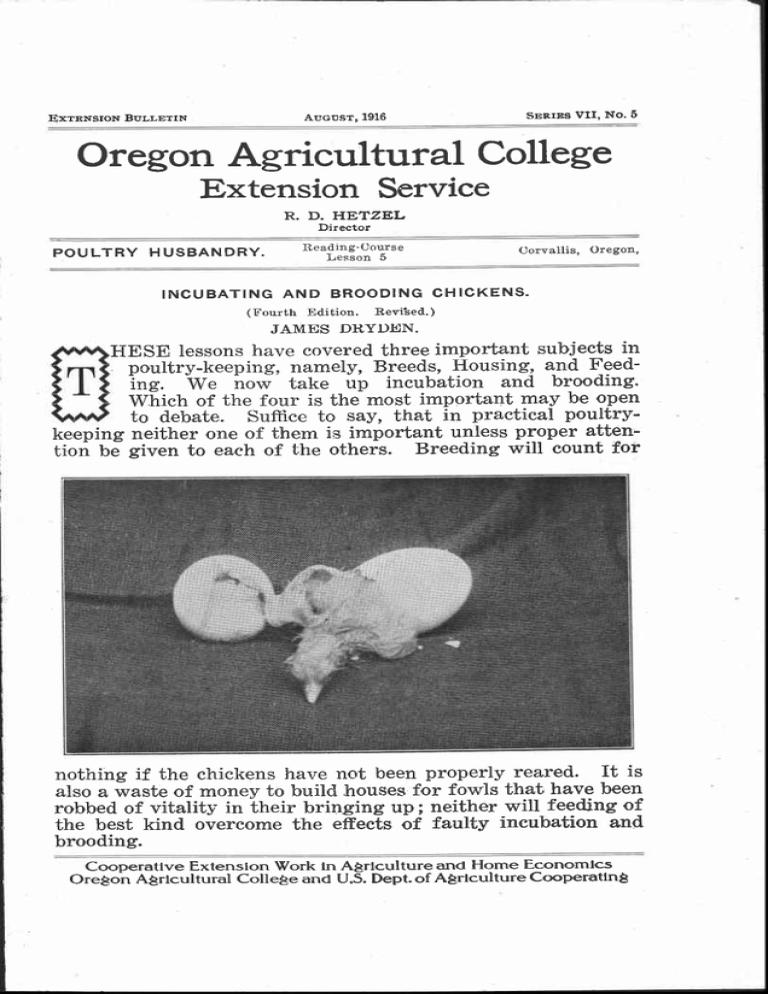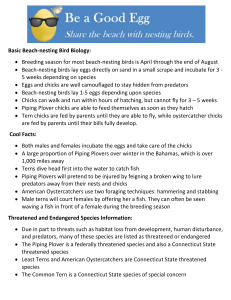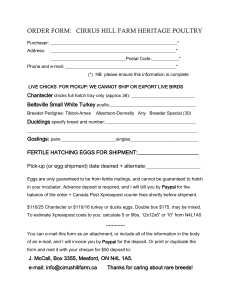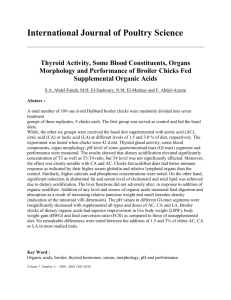Oregon Agricultural College Extension Service
advertisement

AUGUST, 1916 EXTENSION BULLETIN SERIES VII, No. 5 _ — Oregon Agricultural College Extension Service R. D. HETZEL Director POULTRY HUSBANDRY. Reading-Course Lesson 5 Corvallis, Oregon, INCUBATING AND BROODING CHICKENS. (Fourth Edition. Reviled.) JAMES DRYDEN. lessons have covered three important subjects in au and Feed-kee e p i , take u p Breeds, Housing, poultry-keeping, gu l t r lyv incubation now pc) Which of the four is the most important may be open to debate. Suffice to say, that in practical poultrykeeping neither one of them is important unless proper attention be given to each of the others. Breeding will count for HESE O nothing if the chickens have not been properly reared. It is also a waste of money to build houses for fowls that have been robbed of vitality in their bringing up ; neither will feeding of the best kind overcome the effects of faulty incubation and brooding. Cooperative Extension Work in Agriculture and Home Economics Oregon Agricultural College and U.S. Dept. of Agriculture Cooperating 2 The importance of frequently renewing the flock, by killing off the hens about every two years and rearing young stock, was emphasized in Lesson 1, discussing egg production. The old hens are not profitable egg producers. But in renewing the flock, the utmost care must be taken in hatching and rearing to preserve in the new flock the vitality of the old. If the health and vitality of the stock are injured by improper methods of incubation and brooding, and these methods are persisted in year after year, disastrous results will soon be brought about by the very frequency with which the flock is renewed. Decrease in egg production, which we may seek to overcome by frequently renewing the flock, will as certainly result from a gradual lowering of vitality as from keeping the hens till they lose their teeth. It is the opinion of the writer that there are harder problems to solve, and greater difficulty to be encountered by the poultryman, in incubation and brooding, than in any other part of the poultry business. It looks "easy" to see a hen "come off" with a brood of thirteen lively chicks, leaving no "dead in the shell" behind, but when we begin to interfere with the business and try to imp rove on nature's way we are pretty sure to encounter some hard problems. Successful rearing of chickens depends very largely on following closely nature's way. 1. Eggs for Hatchina Must be Produced by Hens of Good Vitality. If we study the way of the hen that hatches every egg in the fence corner, we shall find this fact : The hen that laid the eggs was not confined in close yards she had the liberty of the fields. This guaranteed good health and vigor. Eggs laid by such hens will hatch better than those from hens cooped up under artificial conditions. Health and vitality in the hen are transmitted to the chick. E ggs that hatch well come from hens that have good vitality. Chicks that live well come from eggs laid by hens of good vitality. The method of hatching or the method of broodin g is not always responsible for eggs failing to hatch and for chicks failing to live or grow well. The p arent stock, or the conditions under which the parent stock is kept, are sometimes to .olame. Breeding stock, therefore, should ie carefully selected, only those individuals being retained that are up to a certain standard of shape, size, and vigor. It is not claimed here that lack of vigor in the parents will inevitably be transmitted to the offspring. Parents of apparently weak constitution may breed vigorous offspring. A chicken may have been injured in its rearing and show weakness, without, however, impairing its value as a breeder of 3 strong, healthy stock ; but the poultryman cannot afford to retain in his flock fowls showing constitutional weakness. Lack of vigor in the parent stock may not always show in the offspring, but it will invariably show itself in smaller egg production and in eggs that do not hatch a high percentage of chicks. There may not be constitutional weakness in the fowls that lay the eggs, but if there is lack of vigor there will be correspondingly few eggs that are fertile and fewer of the fertile eggs that hatch. This subject has been emphasized in previous lessons and need not be further discussed here. 2. Methods of hatching sometimes responsible for poor hatches and for lack of vigor in the chicks. Don't always blame the parent stock for poor hatches and for poor chicks. At the Fig. 1. Two chicks of the same age and breed and hatched in the same inonbator. Inequality probably due to a difference in vitality of parent stock. Oregon Station one method of hatching gave an average of 78.8 chicks from a hundred eggs set, while another method gave 60.6 chicks. When brooded in artificial brooders, 90 per cent of the chicks hatched by the first method were alive at the end of four weeks, while only 67 per cent of the others were alive. When brooded under hens, about 98 per cent of those hatched by the frist method were alive at the end of four weeks, ana only 51 per cent of the others. While it is true, therefore, that lack of vigor in the parent stock may sometimes account for poor hatches and low vitality in the chicks that hatch, it is also true that poor methods of incubation may produce the same result. 3. Methods of brooding are sometimes faulty and result in a high d c, ath rate among the chicks and in impaired vitality in those that'grow to maturity. 4 4. Feeding and general care of the chicks is an important part of this subject. It is true that chicks of good vitality will stand a good deal of abuse in the rearing; it is true that expensive foods and much labor in feeding are not necessary to get the best results; but at the same time, to get the rapid growth required of the chicks, they must have proper foods. METHODS OF HATCHING. With the above outline as a guide, let us now discuss some of these points more in detail. Omitting further reference to the first topic, let us consider different methods of hatching. A. Artificial versus natural methods. Nature's incubator is the sitting hen. This does not mean of course that we must always follow nature's way. Modern methods of poultrykeeping are more or less contrary to nature's way of doing things. If ]eft to nature, fowls would roost in the trees and find their own food in the fields and the woods. They would lay their eggs when and where they pleased and hatch and raise the chicks as our China pheasant does. When we want eggs in winter and good market eggs the year around, as well as early spring broilers and winter roasters, we must wean the hen away from nature and put her under more or less artificial conditions. Good poultry keepers have been successful in this. That is why poultry-keeping is a recognized industry of the people. The successful poultryman, however, studies the nature of the hen ; he is guided by nature's teachings. When we fail in the poultry business, it is very often because we fail to recognize this fact and conduct the business under too highly artificial conditions. This of course applies to breeding, housing and general management as well as to incubation. But we are concerned in this bulletin only with incubation and brooding. Artificial incubators have been designed to take the place of hens for hatching. To what extent they have superseded them it is impossible to say. Undoubtedly the larger part of the hashing is done in the natural way. Though thousands of incubators are sold every year, it is an open question whether they are as efficient as hens. During the past few years a great deal of valuable experimental work has been done at different experiment stations on methods of incubation. Experiments at the Oregon Station, reported in Bulletin 100, showed rather conclusively that the hen is more efficient than the incubator. In tests extended from April to July inclusive, with a number of incubators and a great many eggs, the hens hatched more chickens from a giv- 5 en number of eggs than the incubator, and the chicks hatched by hens had greater vitality than those hatched by incubators. The supply of Bulletin 100 being exhausted, a summary of the experiments is included here: 1. From 879 eggs set, incubators hatched 533 chicks, or 60.6 per cent. 2. From 279 eggs set, hens hatched 219 chicks, or 78.8 per cent. 3. Eliminating eggs broken in nests, the hen hatched 88.2 per cent of eggs set. 4. The incubators hatched 78.5 per cent of "fertile" eggs, and the hens hatched 96.5 per cent. 5. Eggs incubated artificially tested 22.7 per cent as infertile, while those incubated by hens tested out 11.8 per cent. 6. The incubators showed 16.6 per cent of chicks "dead in the shell," and the hens 2.8 per cent. 7. Chicks hatched under hens weighed heavier than chicks hatched in incubators. 8. The mortality of hen-hatched chicks brooded in brooders was 10.8 per cent in four weeks, and of the incubator-hatched chicks 33.5 per cent. Fig. 2. A park for brooding chicks at the Oregon Experiment Station. Fifteen to twenty chicks in each coop. 9. The mortality of hen-hatched chicks brooded under hens was 2.2 per cent, and of incubator chicks 49.2 per cent. 10. In other tests the mortality was 46.5 per cent for incubator chicks, brooded by hens and 58.4 per cent brooded in brooders. 11. Hen-hatched chicks made greater gain in weight than incubator chicks, whether brooded by hens or brooders. These experiments were made in the spring and summer months. Incubator chicks hatched in the colder months, for some reason, have greater thrift than those hatched in the warmer months. Chickens hatched in January, February, and March are more easily reared than those hatched in the four following months. It is not assumed that the above results in brooding are the best that may be obtained. It was an incubation experiment. Chicks hatched in different ways were 6 put under like conditions of brooding; and even though the brooding was not the best, the value of the incubation comparison should not thereby be lessened. Incubators may sometimes be used with advantage early in the season or in the winter months when few hens are sitting and when it is desired to get early chickens or broilers. At such seasons where there is a good market for early spring broilers an incubator with good handling may be profitable. On the average farm, however, where fifty or a hundred fowls are kept, the incubator has no place, nor is it essential on a large poultry farm where a thousand or more fowls are kept. Chickens may be reared in large numbers by the natural method. Even though the artificial method gave equally as good Fig. 3. Hen hatching and brooding coop arranged for sitters. results, the outlay in money in fitting the farm with incubators and brooders would be much more than is necessary where the hens are used for hatching and brooding. Cost of Hatching and Brooding Equipment. There is an average of about 50 fowls on Oregon farms, but the number varies from a very few to several hundred. Suppose a farmer keeps 100 hens, the cost for equipment and supplies for hatching and rearing 100 chicks, if artificial methods are used, will be about as follows : 7 1 incubator 150-egg capacity 2 brooders for 100 chicks 2 colony houses Coal oil for incubator, 5 gals Coal oil for brooders, 7 gals. $20.00 20.00 20.00 1.5G 2.10 $63.60 By the natural method the cost will be about as follows: 3 combination hatching, brooding and col$24.00 ony coops 1.00 Feed for sitting hens $25.00 Fig. 4. Hen hatching and brooding coops. Setting the hens. A good incubator with good eggs and good management will produce 100 chicks from 150 eggs. To raise them artificially, it is usually recommended by incubator makers to divide them into flocks of 50 to 75. In this way two brooders will take care of the 100 chicks for about 6 weeks, after which the brooders may be dispensed with and the chicks brought to maturity in colony growing coops. The equipment, therefore, for hatching and rearing 100 chicks, by artificial means consists of an incubator, two brooders, and two colony houses. The cost for equipment and supplies as given above will of course vary. Cheaper incubators may be purchased or higher priced machines may be used. This will apply to brooding. The cost of hatching and brooding equipment may possibly be reduced, 8 so may the cost of brooding coops where large numbers are made. By the natural method of hatching, the cost of the incubator is eliminated, hens taking its place. In the same way brooders are dispensed with. Hens may be set and chicks reared in one coop, or house, such as is illustrated in Fig. 3. Assuming that it requires as many eggs to hatch 100 chicks with hens as with an incubator, three coops costing not more than $8 each will be required, each coop accomodating four sitting hens. By setting the hens at one time the chicks hatched in one coop may be given to two hens to brood. The hens need not be included in the cost of the equipment, for they will be worth practically as much after hatching and rearing their chicks as before. Neither is it necessary to charge the method with eggs that might have been laid by the hens if they had not been used for hatching, It is doubtful if the hen will not lay as many or more eggs during the year if she has hatched and reared a brood of chicks than if her natural instincts had not been gratified. By taking a month or six weeks off for hatching in the spring when eggs are cheap, the hen is usually in better condition and will begin to lay earlier in the fail when eggs are a good price. It is not certain, therefore, that the yearly production of a hen will be lessened by allowing her to hatch and rear a brood of chicks. B. Natural incubation. If a Draper system be followed, chickens may be conveniently and successfully reared in large numbers by the natural way of hatching. One of two methods may be followed. The first requires daily attention in letting the sitters off the nest and seeing that they go back again. By the second method the hen leaves the nest and returns at will. Where it is desired to set a large number of hens, they will be conveniently looked after by making a bank of nests along the side of a poultry house or in some unused shed. The nests should be about 12x12x14 inches in size, made by taking two 12-inch boards for the top and bottom and cutting another 12inch board into 14-inch lengths for the partitions, then nailing them together, as many as desired. The top of the bottom row will furnish the bottom of the second row, and 4 or 5 rows of nests may thus be placed together. There should be a hinged board at front to confine the sitters. The hens should be let out every day to eat and drink for about fifteen minutes, the length of time depending on weather conditions. Several inches of fine waste hay should be placed in the bottom of the nests. Short-cut straw or clean chaff will answer the purpose. When 9 the chicks hatch, about twenty of them may be given to a hen to brood, and the remaining hens reset. The hen and chicks may be put in a coop such as is shown in Fig. 7. This will afford them shelter for a month or six weeks, after which a larger coop in which they can be brought to maturity will have to be provided. Or the small coop may be dispensed with, and the hen and chicks transferred at once to the larger coop. A coop the size of that illustrated in Fig. 3 is large enough to rear the chicks of two hens, or forty chicks. The second method of hatching and brooding by hens requires less care on the part of the attendant. We have found it to work well at the Oregon Station. One coop serves for both hatching and rearing the chicks. (Fig. 4) . It serves the triple purpose of an incubator, a brooder, and a colony house. A convenient size of coop is 5 feet long and 3 feet wide, with a shed roof 3 feet high at front and 2 feet high at back. It is large enough to divide into separate apartments for four sitting hens. Movable partitions of canvas or burlap are fastened to a 4-inch or 6-inch board at the bottom and to a cross-piece at the top. It has an outside run 3 feet long for each hen, covered with wire netting, as shown in the illustration. The runs are hooked on to the house and may be dispensed with when the chicks are hatched. These runs give the hens opportunity for dusting and exercise. By keeping feed and water before them all the time, the sitters may be allowed to leave the nests and return at will. In this way, very little labor is required in caring for sitting hens. The door on the front is hinged at the top. Underneath this there is a frame of wire netting of oneinch mesh ; in mild weather the door may be kept open. This makes it an open-front house, and during the summer months, when the growing chicks use it as a roosting house, it will be found that this provision for fresh air is a necessary one. More conveniently to get at the nests or sitters, there is an opening at the back of the coop. The top board, which is 10 or 12 inches wide, is hinged at the bottom and cut in the center, one door serving for two nests. It is also an advantage to put hinges on the roof so that it may be opened. In dry locations and where the house can be moved to fresh ground occasionally, floors are not necessary or desirable. In some localities where rats are a pest, a floor will serve to prevent losses of eggs and chicks. C. A "fireless" and "henless" brooder. Sometimes it is desirable to rear hen-hatched chicks in a brooder without the hen. We give an illustration of a homemade brooder in Fig. 10 10. It is made out of a dry-goods box, a little burlap or flannel, and a gallon vinegar jug. The box may be 3 to 4 feet long, 21/2 feet deep, and 21/2 feet wide, set on edge. Large sized boxes, however, may be used. The hover should be about 2 feet square, high enough to put the jug under it. Strips of burlap about 4 inches wide are tacked on to the under side of the hover top, which is made of plain matched boards. These strips hang down all over the chicks, not merely around the edges of the hover, and the chicks nestle among the strips of cloth. .The jug is filled with hot water and placed underneath in the center of the hover. If the water is too hot a little felt should be wrapped around the jug to avoid burning the chicks. This will also help to retain the heat longer. During the first week, the jug should be refilled night and morning. As the chicks grow older, once a day will be often enough. In warm weather the jug may be dispensed with when the chicks Fig. 5. Illustrating a new brood coop designed at the Oregon Station. are two weeks old. Later, the hover may be removed and the box, as shown in Fig. 10, used for brooding the chicks till they are about 3 months old. This brooder will easily take care of fifty chicks. They should be given more room when two or three months old. In such a brooder, with felt or burlap strips hanging over the chicks, very little artificial heat is required to keep them warm, as they keep themselves pretty comfortable when all are close together under the hover. Such a brooder may be used for both hen-hatched and incubator chicks. Fireless brooders of this kind will rear chicks successfully, but. a fireless brooder without heat of any kind is not practicable. If the weather is not too cold and the chicks have close attention, the heatless brooder may raise chicks successfully, but the labor cost is great. D. A new brood coop. (Fig. 6.) This coop may also be used for the sitting hen. It is rat proof and rain proof. The 11 wire front affords provision for fresh air. The netting is of one-inch mesh. The door, which slides up and down, may be fastened with a wooden pin, to allow the chicks to come out, while the hen is confined. The bottom is separate to afford easy cleaning. To clean, the floor is pulled from under the coop, or the coop is lifted to one side. Where there is no danger from rats or other vermin and the ground is not too damp, the floor may be dispensed with. The roof is likewise separate. This makes it more convenient to catch the hen or the chicks. The roof is made of flooring and the sides of shiplap. To prevent rain beating into the coop and also to protect the Fig. 6. Hen brood coop in use. brood from the sun in hot weather, a shield is provided, as shown in the cut, hanging at different angles. When not in use, this shield is pushed back under the roof. To keep the shield from falling down when it is pulled out, two pieces of strap iron, with proper bend, are fastened to the board. For further details, see working plan, Fig. 8. Selecting Eggs for Hatching. It is not possible to determine whether a fresh egg is fertile or will hatch. The egg must be under the sitting hen or in the incubator several days before its fertility may be determined. Neither is it possible to tell from any differences in shape of the egg whether it will hatch 12 a male or female chick. The shape or size of the egg has nothing to do with the sex of the chick. There are certain points in shape and structure of the egg, however, that should be considered in selecting eggs for hatching. Normal eggs should be selected. This does not mean that the eggs should be all of the same size. Eggs laid by different hens vary in size even when the hens are of the same breed. One hen may lay an egg weighing more than two ounces; another, less than two ounces. The most profitable hen is not necessarily the one that 109 \I\Z\A Rook Re, mos, d c\T cV lays the largest egg. The hen that lays small eggs may produce so many more of them in a year that she will lay a greater weight of eggs in a year even though her eggs average much less in weight. The large egg may be normal for one hen and the smaller egg for the other. Other things being equal, the one will hatch as well as the other. The size of egg is a matter of breeding or heredity. It is well to use the larger eggs for hatching, because in that way it will be possible in a few years to breed up a strain of fowls that will lay larger eggs. Abnormally large or small eggs should not be used for hatch- 13 ing. Eggs that are not normal in shape should also be discarded. Ill-shaped, rough-shelled, dirty eggs should not be used. It is very important to select fresh eggs, the fresher the better. It is possible to keep eggs several weeks and have them hatch. but eggs seem to lose in hatching quality the longer they are kept. They will keep in a cool place better than in a warm place. They should not be kept in a damp room. It is a good plan to turn them once a day, handling them with clean hands. There is a great difference in eggs in fertility and hatchability. One of the chief causes of infertility in eggs is close con- nut !)i e shot, 1,ox, which is shown Pig. H. I brmIti enop for hen and ,hio 111ftlit. lumber la one-half inch thick, Bides and floor on left of picture without cover. of the coop are 2 feet 6 inches and It is 2 feet deep. Door opening is 10x12 inehes. It is made of -wire netting to provide the hen and chicks with plenty of fresh air. tasking one-inch wire netting onto a frame. which works up and In this The door is made by down in a g-r.mre. A. pin at the top holds the door at any desired opening. in at Will. B y clos out way the hen may he confined while the ellicku may rrim ing, the e rat and vermin proof. For conTenince in clean ing the door, the coop in By removing the hock, back of the coop is made s.marote and hooked on to the coop. the floor may he easily swept and ueruped out, mi finement of the layers. Experiments have shown that eggs produced by fowls on free range are more fertile and hatch better than those from fowls confined in yards. (West Virginia Bulletin 71.) In these experiments about three times as many eggs tested infertile from the confined fowls as from those having unrestricted range. Whether the increased fertility from the latter was due to possibly greater exercise or to natural foods found on the range, the experiment does not show. So much importance, however, is placed on this point 14 that many of the large hatcheries refuse to use eggs that have been laid by hens that enjoy free range. Feed the sitters corn or wheat, all they will eat, and provide grit, water, and a little green food. Provide also a box of earth for dusting; earth should not be too dry. The hen will usually hatch best in a nest on the ground, but the ground should not be too hard. Cover it with chaff, or short straw or hay. If the hen is set on a board floor, put in Fig. 9. A "fireless" and "henless" brooder. two or three inches of moist earth, hollow the nest slightly in the center and cover with straw or hay. Planer shavings are also good nesting material. Dust the hens with a good insect powder or tobacco dust when setting them ; and again, ten days later, rub it well into the roots of the feathers. Put a spoonful of the same material, or a moth-ball, in the center of the nest. With this treatment the hen should be free from these pests during the period of incubation, if the house or box in which she is sitting is not infested with them. If necessary, dust the hen oftener. 15 After six or seven days of incubation, the infertile eggs may be taken out and saved for the chicks. Rotten eggs should also be removed. If a number of hens are set at one time, they may be doubled up after testing; that is, if as many as a setting are tested out, one hen may be reset on fresh eggs. An egg tester may be purchased from a poultry supply house, or a small box may be used in which an electric light globe or a coal oil lamp or candle may be used as an illuminator. In one side of the box cut a hole about the size of an egg. Testing is done in a dark room or at night by holding the egg to the light at the hole in the box. An infertile egg will look clear, just like a fresh egg, only it has a little larger air cell. A fertile egg will show dark. Points on Setting a Hen. The best sitters are the breeds of the American and Asiatic classes, The Mediterraneans, such as Leghorns, Minorcas, Andalusians, are not good sitters. Hens of gentle disposition should be chosen if possible. One good broody hen will take care of twenty chicks. Another advantage of setting several hens at a time is that the chicks may be "doubled up." Dust the hen with insect powder when taking her off the nest. Examine the heads of the chicks two or three days afler hatching, and if lice are found, rub a little lard on the head and under the throat. If the hen has been properly treated for lice while sitting, there will be no necessity for treating the chicks for lice. But watch them. Moistening the eggs before hatching is not necessary. The hen attends to that herself. Keep the hen and the chicks on clean grass runs if possible. If properly managed, the hen may be got to laying after being with the chicks two or three weeks. In warm weather the chicks may be "weaned" when a month old. Maturing the Chickens. After the chicks have passed the brooding stage, they should have ample roosting quarters and runs. Serious results will follow if they are crowded in small ill-ventilated quarters. They should have abundance of fresh air, without drafts. They will do better roosting in the trees will than in a crowded or drafty house. An open shed that shelter them from winds and the rains is all that is necessary. The open-front coop, illustrated in Figs. 3 and 4, will accommodate thirty to forty chickens till they are mature. With such a house and given free range and some shade, the chickens will require very little care during the summer, and they will grow and thrive and be a delight to their owner "when the frost is on the pumpkin."




![Information-about-Emus-E2-August-Week-6-1gssrwn[1]](http://s2.studylib.net/store/data/009885786_1-bd45c822c216cb2e8ac8bd79e7ddb6d0-300x300.png)
